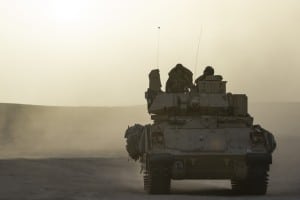The Army is aiming to select five vendors at the end of fiscal year 2021 to provide digital designs for its revamped Optionally Manned Fighting Vehicle (OMFV) competition, with plans to award a production contract in FY ‘27 and equip first units in late FY ‘28.
Officials provided the most extensive details to date for the rebooted Bradley replacement program on Tuesday, releasing an “industry narrative”
document outline for the five-phased OMFV effort in lieu of an industry event canceled due to coronavirus pandemic.

“Two-way information sharing between potential industry partners and the Army remains critical as we move forward with the OMFV program. As we progress through the first-phase of our five-phased approach, communication, feedback and innovative thinking from industry remains key,” Maj. Gen. Brian Cummings, program executive officer for ground combat systems, said in a statement.
The Army announced in mid-January it would cancel its acquisition effort for OMFV, which faced scrutiny after a single bid sample from General Dynamics [GD] was accepted for the program’s prototype phase.
The new effort begins with a focus on digital designs, with the Army conducting market research throughout the year before releasing an RFP in the second quarter of FY ‘21.
“It is critical during Phase 1 of this effort that industry partners provide candid feedback back on this proposed acquisition approach and on the ability to meet the characteristics based on the schedule and funding proposed,” the Army wrote in its note to industry. “During [the second] phase, the Army intends to utilize virtual reality and modeling & simulation to verify that preliminary digital designs are operationally suitable and technically achievable.”
In FY ‘23, the Army will downselect from five to three vendors to continue working on digital prototype designs, eventually culminating in critical design reviews (CDR).
“The purpose of the CDR is to ensure that the vendors’ proposed detailed designs are adequate to proceed into fabrication, system integration, demonstration and test and can meet stated performance requirements within budget, schedule, and risk parameters. Long lead items are planned to be accommodated,” the Army wrote.
Phase 4 will move OMFV toward building physical prototypes, with vehicle tests to begin in FY ‘25 and run through early FY ‘27.
The Army noted that competitors not included among the five delivering digital designs in phase two will still have the chance to compete for phases three and four.
A production for one vendor to build the Army’s Bradley replacement is then expected to be awarded in the second quarter of FY ‘27, before equipping first units at the end of FY ‘28 and entering full-rate production in FY ‘29.
Along with the detailed program timeline, officials included the full list of OMFV “characteristics” rather than more prescriptive requirements, ordering them in priority: survivability, mobility, growth, lethality, weight, logistics, transportability, manning and training.
“We recognize the importance of accurately defining the required set of capabilities without over constraining the design,” Brig. Gen. Ross Coffman, director of the Next Generation Combat Vehicle Cross-Functional Team, said in a statement. “Everything we are doing now with industry will help ensure the Army gets the characteristics right up front to properly inform the requirements that will be set in the future.”
Senior Army officials previously told lawmakers the service has received interest from at least 11 companies in the restarted OMFV competition, with a belief that the original group of competitors will look to participate again as well (Defense Daily, March 5).
“We have seen a robust interest from industry – from traditional vendors to innovators and from small businesses to consortium,” Cummings said. “We are actively posturing ourselves to be in a stronger competitive situation moving forward.”